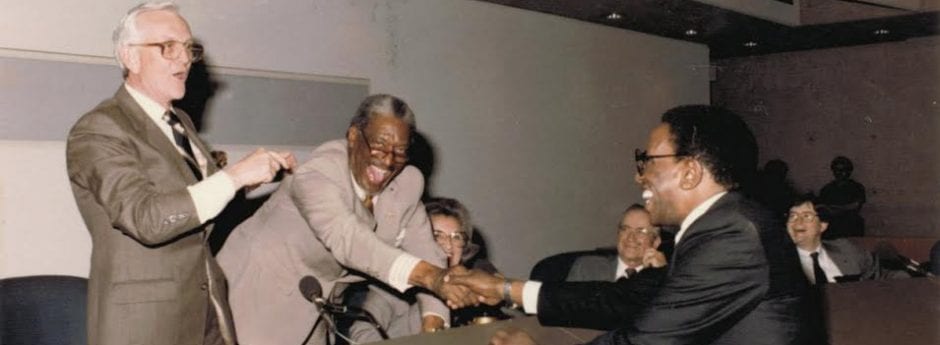Apartheid was a violently oppressive form of rule that took place within South Africa from 1948 to 1994. In South Africa, races were separated from one another but Black South Africans were ostracized from society by political and social means. Racial segregation had already been in existence, but in 1948, the new apartheid policy created a more standardized approach that was far more repressive. As the rest of the African continent was beginning to gain independence throughout the mid twentieth century, South Africa remained in a repressive regime. For a time, the rest of the world did not want to acknowledge what was occurring in South Africa. Many countries continued to support the South African regime through investment. At the time, many people were willing to look past the country’s questionable human rights issues to use its economy to make a high rate of return on their investments. It was not until later in the regime after several incidents including Sharpeville and Soweto that the issue became difficult to ignore. Many Americans saw the struggle for the end of South African apartheid as being equivalent to or on par with the American Civil Rights Movement. Thus, many supporters of the Civil Rights movement began vocalizing more and more about drawing attention to the South African cause and pushing for divestment. The United Methodist Church was also vocal about South Africa’s human rights abuses and were concerned for the people of South Africa.
The United Methodist Church was created in 1968 with the merging of the Evangelical United Brethren Church and the Methodist Church. This brought together both White and African- American congregations (Bloom and Gilbert). The United Methodist Church is organized by the General Conference, the Judicial Council, and the Council of Bishops. There is no single leader; all groups work together (Bloom and Gilbert).
The Methodist Church’s feelings on South Africa were first briefly mentioned within the United Methodist Church 1972 General Conference Journal discussing colonialism and racism within the country (Journal 1972 1133). The subsequent conference in 1976 included a larger discussion on Human Rights in Southern Africa (Journal 1976 1134). In the 1980 United Methodist Church General Conference within the Church and Society Committee Report No. 65 there was a call to eliminate the system of Apartheid (Journal 1980 845-827). As the years progressed, issues within South Africa were harder to hide from the rest of the world. At these General Conferences, there were representatives from several different countries who were all aware of what was occurring in South Africa and wanted the issue resolved and a new government put in place. In the United States, South African apartheid was a divisive issue. Many African Americans equated the struggle for Blacks within South Africa similar to the Civil Rights Movement within the United States. Both groups were being segregated and subjugated by their governments. The Pan Africanist movement quickly picked up support, because it was easy to align the American Civil Rights struggles with the violence in South Africa. Pan Africanism is solidarity between people of African descent.
The World Methodist Council was prepared to encourage change in South AFrica, but its black caucus pushed the council to be less passive in their encouragement. Ultimately, “The World Methodist Council, with 500 members representing 90 countries, has called for comprehensive economic sanctions against South Africa… the only abstainers were members of the delegation from the Methodist Church of South Africa” (Harrison). In 1986, the United Methodist Church “urged its operating agencies to follow one of three courses; shareholder advocacy, selective divestment or full divestment (Berger NYT). But in response to this announcement the “black caucus of the United Methodist Church denounced the board for moving too passively and said it was violating Christian principles and enhancing apartheid” (Berger NYT).
At the local level, there were many cases of United Methodist Churches who were opposed to apartheid and were interested in divesting church funds from the country of South Africa. For example, St. Luke Community UMC in Dallas, Texas. It was one thing to go to a Conference every four years and discuss the injustices occurring. Instead, many churches wanted direct action. But this was difficult; churches need money to pay for their goodwill. Divesting was hard to follow through on because “Some of their own (church leaders) sat on the boards of corporations and banks which were heavily involved in supporting apartheid” (Carstens 21). It was a classic conflict of interest, leaving many churches with their hands tied. “Churches could hardly expect support from government and business about sanctions when churches were also profiting”. The United Methodist Church were very open to discussing the issue of Apartheid at their Conferences and vocal about their stance on the violence occurring within South Africa.
The United Methodist Church would eventually divest in 1986 and South African apartheid would officially end in 1994.
Works Cited
Berger, Joseph. (1986, Jun 10). “Protestants Seek More Divestment.” New York Times (1923-Current File)
Bloom, Linda, and Kathy L. Gilbert. “United Methodists Achieve Milestones despite Differences.” The United Methodist Church.
Carstens, Kenneth. “Apartheid, Church and Politics: The Response of the Church in the USA to Apartheid.” Africa Today 14, no. 1 (1967): 19-22.
Harrison, Charles. “Methodist Call for a Boycott; World Council calls for sanctions against South Africa.” Times [London, England], July 28, 1986. Academic OneFile
The United Methodist Church General Conference Journal 1972, 1972, 1133.
The United Methodist Church General Conference Journal 1976, 1976, 1134.
The United Methodist Church General Conference Journal 1980, 1980, 845-847.
